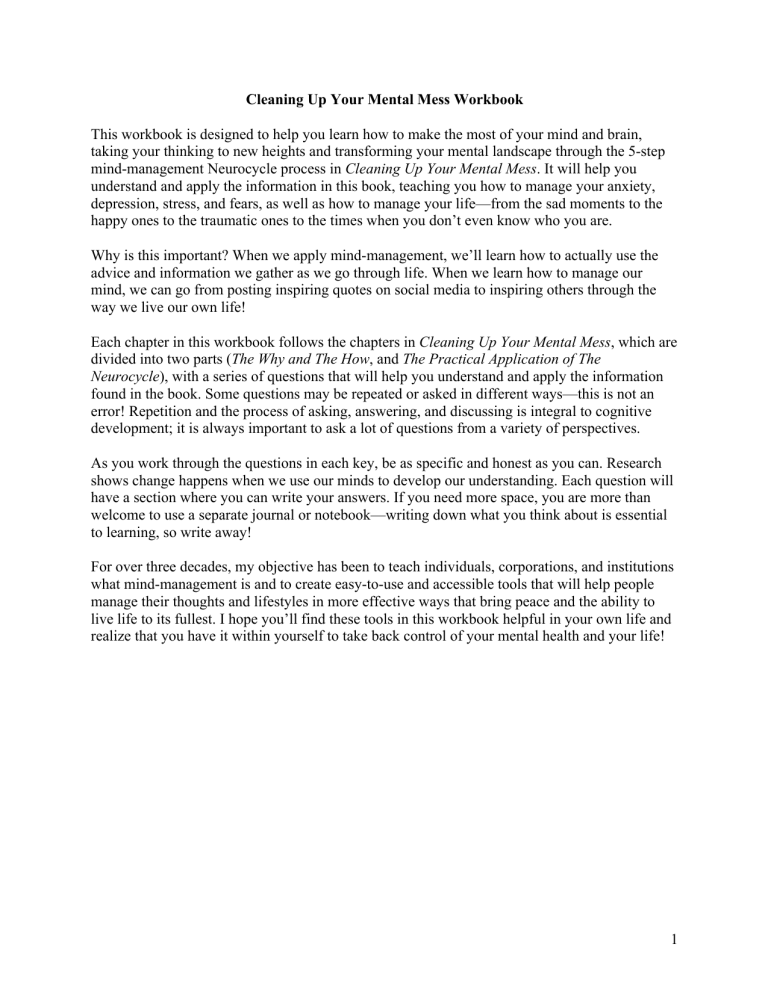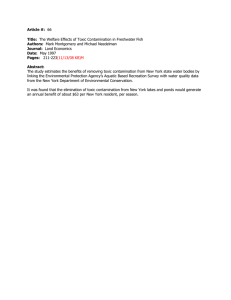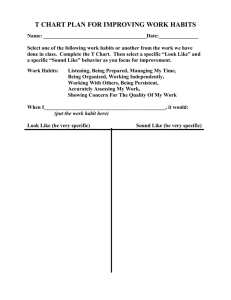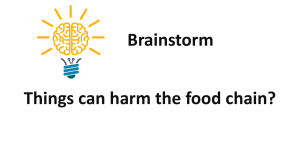
Cleaning Up Your Mental Mess Workbook This workbook is designed to help you learn how to make the most of your mind and brain, taking your thinking to new heights and transforming your mental landscape through the 5-step mind-management Neurocycle process in Cleaning Up Your Mental Mess. It will help you understand and apply the information in this book, teaching you how to manage your anxiety, depression, stress, and fears, as well as how to manage your life—from the sad moments to the happy ones to the traumatic ones to the times when you don’t even know who you are. Why is this important? When we apply mind-management, we’ll learn how to actually use the advice and information we gather as we go through life. When we learn how to manage our mind, we can go from posting inspiring quotes on social media to inspiring others through the way we live our own life! Each chapter in this workbook follows the chapters in Cleaning Up Your Mental Mess, which are divided into two parts (The Why and The How, and The Practical Application of The Neurocycle), with a series of questions that will help you understand and apply the information found in the book. Some questions may be repeated or asked in different ways—this is not an error! Repetition and the process of asking, answering, and discussing is integral to cognitive development; it is always important to ask a lot of questions from a variety of perspectives. As you work through the questions in each key, be as specific and honest as you can. Research shows change happens when we use our minds to develop our understanding. Each question will have a section where you can write your answers. If you need more space, you are more than welcome to use a separate journal or notebook—writing down what you think about is essential to learning, so write away! For over three decades, my objective has been to teach individuals, corporations, and institutions what mind-management is and to create easy-to-use and accessible tools that will help people manage their thoughts and lifestyles in more effective ways that bring peace and the ability to live life to its fullest. I hope you’ll find these tools in this workbook helpful in your own life and realize that you have it within yourself to take back control of your mental health and your life! 1 PART ONE: THE WHY AND THE HOW 2 Chapter 1: What Happens When We Don’t Use Our Minds Correctly 1. Mind-management is a skill that needs to be learned and constantly upgraded as we grow from childhood into adulthood. For every new experience we need a new set of mindmanagement tools. How do you understand “mind-management”? Why does it constantly need to be “upgraded”? Why is mind-management so important? 2. Feeling guilty because you “failed to think positively enough,” “didn’t have enough faith,” or didn’t reach some “ideal” is damaging to your psyche and your physical body. Why is this the case? Have you experienced this in your life? 3. Everything in our society seems to convey the message of “now!” It’s almost as if we’ve entered an era where we have sacrificed the processing of knowledge for the gathering of data. What does this mean? Can you think of some examples of this in your own life? How does the demand for quick results and solutions, in “now!” time, impact our mental and physical health? 4. Mental distress and ill-health are not new. Humans have always battled mental health issues. What does this statement mean? How is it different, or similar, to current views of mental ill-health? 3 5. We can’t control the events and circumstances of life but can learn to control our reactions, which help us deal with and manage the many challenges we face. How do you understand this? Is this something you have experienced in your own life? How does this relate to mind management? 4 Chapter 2: What Is Mind-Management and Why Do We Need It? 1. The way we use our minds helps us go from just hearing good advice to living a good life. What does this statement mean? Is this something you feel you need in your own life? 2. We all have to learn how to catch and edit our thoughts and reactions before they trigger toxic chain reactions and become ingrained neural networks, a.k.a. bad habits. Why is this the case? How do toxic thoughts become bad habits? 3. As we think, the brain literally changes in hundreds of thousands of ways, on cellular, molecular, chemical, genetic, and structural levels—the key is that you can direct this process! How do you understand this? How do we direct this change? 4. How we react or respond to various life situations and the world around us is called mind-in-action. What is the mind-in-action? Is it something we can control, or does it control us? 5 5. Any brain, at any age, and no matter what has happened to it, can be made to function at a higher level because of the nature of neuroplasticity. Why? What is neuroplasticity and why is it important? Does this give you hope? 6 Chapter 3: Why the Neurocycle Is the Solution to Cleaning Up Your Mental Mess 1. Simple mind-management tools for personal use can help innumerable persons of all ages experience improved mental and physical health and well-being. What does this statement mean? What are simple mind-management tools? Have you experienced this in your own life? 2. When you learn how to clean up your mental mess, you become a “first responder” and decision maker in your life. What does being a “first responder” to life mean? Did we see this in our clinical trials (discussed in detail in this chapter and chapter 4)? Is this something you want to learn how to do? Why? 3. Empowerment is that missing link that gets you from point A, hearing or reading good advice, to point B, actually applying it in a meaningful and sustainable way. What does this statement mean? Why is empowerment so important? How can someone feel empowered? How is this “sustainable”? 4. The Neurocycle provides a pathway to empowerment. What does this mean? What is the Neurocycle? How is it related to mind-management? What is the pathway to empowerment? 7 5. New thoughts are formed over twenty-one days, and these new thoughts are formed into habits after sixty-three days. What does this mean? How long does it take to actually build a new thought habit? Why is this important? 8 Chapter 4: The Research 1. Your toxic stress and anxiety can be reduced by as much as 81 per- cent using the 5 Steps of the Neurocycle. How so? Is this what we saw in our research? Does this give you hope? 2. Increased autonomy leads to increased awareness. How so? Why is awareness so important? Is this something you have seen in your own life? What is the best way to handle this awareness? 3. The 5 Steps can improve your overall psychological feelings of well- being, giving you a more positive outlook on life. How so? What are the 5 steps? 4. As you use the 5 Steps daily, barriers and challenges that inevitably arise in life won’t throw you as much—you will start seeing them as opportunities and possibilities! How so? Why is it important to see challenges as opportunities? Is this something you have experienced in your own life? 5. Our life experiences are reflected in our biology. What does this mean? How did we see this in our research? 9 10 Chapter 5: How Can All This Science Help You? 1. Even if we still feel anxious or depressed, acknowledging, embracing, and processing our issues will optimize brain function and create coherence, which will give us the ability to see our issues clearly and deal with them. Why is this the case? Is this something you have seen in your own life? Did we see this in our research? 2. Uncontrolled, toxic thinking has the potential to create a state of low-grade inflammation across the body and brain, adversely affecting cortisol levels, hormones, brain functionality, and even the telomeres on the chromosomes. Why does this happen? Is this because of the brain-body connection? How do our thoughts impact our biology? 3. People who have been taught to “tune in” to their nonconscious mind to manage their thought life and “detox” and “build” the brain are better able to navigate the ups and downs of life because they have a sense of control, which gives them hope. Did we see this in our research? What does it mean to “tune in to the nonconscious mind”? Is this something you need in your own life? How does this give someone hope? 4. You can think of coherence as many parts of the brain working together in harmony. Why is this important? How does this happen? Did we see this in our research? How can you use this information in your own life? 11 5. We can’t hide what we’re thinking from our brains. Why? Have you seen this in your own life? How does this relate to the importance of mind-management? 12 Chapter 6: What is the Mind? 1. Your mind is not your brain, just as you are not your brain. What does this statement mean? How is the mind different to the brain? 2. When you think, you will feel, and when you think and feel, you will choose. What does this mean? How does this relate to the “mind-in-action”? Do thinking, feeling and choosing go together? 3. A thought itself is the concept, the big idea. What does this statement mean? How are thoughts different to memories? What are the different parts of a memory? Where are thoughts located? 4. During the day you think, feel, and choose to build new thoughts into your mind and brain; at night you think, feel, and choose to sort out the thoughts you have built during the day, which provides the content for dreams. What does this mean? Why is it important? 5. Self-regulation is the overarching catalyst of successful mind-management. What is selfregulation? Why is it so important? Is this something you need in your own life? 13 14 Chapter 7: The Interconnected Mind 1. Whatever we think about the most grows, because we are giving it energy. What does this mean? Why does this make mind-management important? 2. The mind is divided into the conscious mind, the nonconscious mind, and the subconscious mind. What are the differences between these three parts of the mind? How do they work together? Why is this important? 3. We don’t need to be held captive to our thoughts; instead, we can “capture” our thoughts. What does this mean? Is this something you need to learn how to do in your own life? 4. Whatever you experience in your mind will also be experienced in your brain and body. Why is this the case? Is this something you have experienced in your own life? How can you use this to your advantage? 5. Dealing with our toxic thoughts and traumas means that all this swirling, chaotic, toxic energy needs to be transferred from the negative thought to the reconceptualized, healthy thought to re- store balance and coherence to the mind. What does this statement mean? How do you do this? 15 16 PART TWO: THE PRACTICAL APPLICATION OF THE NEUROCYCLE 17 Chapter 8: The 5 Steps of the Neurocycle 1. Mind-management, when done correctly, helps facilitate “talk” between the conscious, subconscious, and nonconscious mind. What does this mean? Why is this “talk” important? 2. We are not prisoners to the contents of our mind, whether they come in the form of an anxious thought, a depressive feeling, and/ or a painful memory. Have you ever felt like a prisoner of your own mind? Is there a healthy way to deal with painful thoughts or feelings? 3. The Neurocycle builds memory effectively and in an integrated way, helping us manage the contents of our mind. How so? What is the Neurocycle? What are the 5 steps of the Neurocycle? 4. The 5 Steps function like a delivery company, which works no matter what the parcel is, where it comes from, or where it’s going. What does this mean? How is this useful in your own life? 18 5. Reconceptualizing means redesigning the thinking, feeling, and choosing behind the thought by learning from the lessons of the past. What does this mean? Why is it important? Is this something you need to learn how to do in your own life? Why? 19 Chapter 9: Directing Your Brain for Change 1. We have within us the ability to tap into a state of self-awareness that allows us to develop a sense of peaceful control, a mental space necessary for coping and overcoming. What is this ability? How can you use it in your own life? 2. When you use your ability to stand outside of yourself and observe your own thinking (the MPA), your senses can tune in to the detail of the “now moment”. What does this mean? What is the MPA? Why is it important to tune into the “now moment”? How do you do this? 3. The discomfort zones are the physical, emotional, and informational warning signals from physical, emotional, and informational memories in a thought. What are the discomfort zones? How can we use them to our advantage? Why is it important that we learn to listen to these warning signals? Have you experienced this in your own life? 4. Self-regulation develops the more you use it. What does this mean? What is selfregulation and why is it so important? How does self-regulation relate to the other directed neuroplasticity techniques discussed in this chapter? What is directed neuroplasticity? 20 5. Not only can we rewire our brain but we can regenerate it as well! What does this mean? How can we regenerate and rewire our brains? Why is this important? 21 Chapter 10: Why It Takes 63-Days of Neurocycling to Form a Habit 1. Building useful long-term thoughts into habits and detoxing toxic thoughts and traumas through directed neuroplasticity requires time and hard work and needs to be done regularly, as an ongoing process. Why? Is this something you do occasionally when you are dealing with an issue, or as a lifestyle? How long does it really take to form a habit, and why? 2. Limit the time you spend detoxing toxic habits and trauma to around seven to thirty minutes a day. Why is this so important? What can happen if you don’t do this? 3. You need to keep learning every day for mental health. Why is learning so important for mental health? What is learning? 4. We don’t need to be held captive to our thoughts; instead, we can “capture” our thoughts! What does this statement mean? Is this something you need in your own life? Why? 5. The toxic energy from toxic thoughts accumulates if it isn’t dealt with, and will eventually explode in a volcanic and uncontrolled way. Why is this the case? Is this something you have experienced in your own life? How do we prevent this from happening? 22 23 Chapter 11: Neurocycling to Build Your Brain and Develop Mental Toughness 1. The brain isn’t a fixed lump of matter delivering genetically preprogrammed instructions to the body. Why? What is the brain? Can the brain change? What does this mean for you? 2. There’s something we can do to help the brain function well and build resilience against the challenges of life: brain-building. What is brain-building? How does it strengthen the brain? 3. Brain-building is, quite simply, using the 5 Steps in an organized way to learn new information—directed neuroplasticity at its finest! What does this statement mean? 4. There’s another great benefit to brain-building: it’s a neuroplasticity-driven system that keeps the brain tidy and clean. How so? What are some of the other benefits of brainbuilding? Is this something you need in your own life? 5. Here is one more reason why brain-building is amazing and so vital: it can help you get “unstuck” in any area of life, such as in a job, in a relationship, or with a project. Why is this the case? How can you use this in your own life? 24 25 Chapter 12: Neurocycling to Detox Trauma 1. When you find yourself becoming defensive or trying to distract away the awareness, lean in to what you may be trying to avoid. Why is this important, even though it may be uncomfortable? Have you experienced this in your own life? 2. Toxic trauma involves something that happened to us that was out of our control, and often results in a pervasive feeling of threat. What does this statement mean? What are the different types of trauma? Have you experienced toxic trauma in your life? 3. Trauma is probably the hardest thought pattern to work on, which is why so many therapists and counselors spend years working on trauma with their clients. Why is this the case? What makes overcoming trauma so challenging? 4. The Neurocycle is not designed to remove all our suffering. Rather, it helps us reconceptualize it. What does this mean? Why is this the case? Is this something you need to learn how to do in your own life? 5. We have the power to control our reactions in this moment as we draw on the wisdom of the nonconscious mind to manage a crisis. What does this statement mean? What is this power, and how do you use it? Why is this important? 26 27 Chapter 13: Neurocycling to Break Bad Habits and Build Good Lifestyle Habits 1. If you’re constantly stressed during the day, and you don’t take the time to organize your thinking and reboot the brain, this can affect your sleeping patterns at night. How so? Have you experienced this in your life? 2. When it comes to diet, there is no “one way” of eating. Each human being is unique. Is this statement true? If so, why? Have you seen this in your own life? How can you develop a better way of eating, or eating mindfully? 3. Exercise can improve all areas of cognitive function, including mood, thinking, learning, and memory, especially with age. How so? Have you seen this in your own life? What are some ways you can build a better exercise routine? 4. Toxic habits are negative behavioral patterns we have established over time. What does this mean? How do we build toxic habits? What toxic habits do you want to get rid of in your own life? 5. A thought that’s established is a thought that’s gone through the cycle of being built into long-term memory and automatized over time, which happens over a period of around sixty-three days. What does this mean? How can this be a good thing, and how can this 28 be a bad thing? How can you use this information to unwire bad habits in your life? How does this relate to mind-management? 29 Chapter 14: Neurocycling as a Daily Mind-Management Routine for Cleaning Up the Mental Mess 1. When we wake up in the morning, our first priority should be to get our mind into the right mental space for the day. Why is this important? What does this mean? Is this something you need to do in your own life? How? 2. Brain-building is a great way to calm down, especially if you have just had a bad argument or are in a toxic situation. Why? What does this mean? Is this something you want to start doing in your own life? 3. How you use your mind to manage your mind is so incredibly important. Why? What does it mean to use your mind to manage your mind? 4. Thinker moments are super easy to do, but in today’s busy world we have to train ourselves to do them. What are “thinker moments”? Why are they important for brain and mental health? How can you use “thinker moments” in your day? 5. Mind-management is, in my opinion, one of the most important tools—if not the most important—in your mental toolbox, because it will help you live a longer, healthier, and 30 happier life. Why is this the case? How can you use mind-management to improve your life? 31


